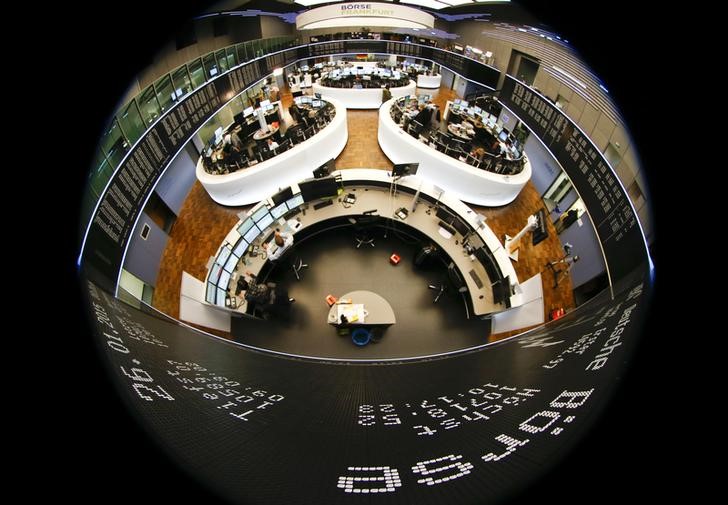* Draghi highlights soft inflation outlook
* Euro falls below $1.07
* US-German 5-year bond yield spread widest since 1999
By Jamie McGeever
LONDON, Nov 12 (Reuters) - A signal from European Central
Bank president Mario Draghi that further policy easing is coming
next month drove European markets on Thursday, sparking a brief
rebound in stocks and pushing the euro and bond yields lower.
In an address to the European Parliament Draghi said
inflation dynamics had somewhat weakened and that a "sustained
normalisation" of inflation could take longer to achieve than
thought.
"At our December monetary policy meeting, we will re-examine
the degree of monetary policy accommodation," Draghi said.
Stocks reversed earlier losses, although high-profile
corporate profit warnings eventually weighed on sentiment, while
the euro sank half a percent below $1.07 and the gap between
5-year U.S. and euro zone bond yields hit its highest since
1999.
"It now seems likely that the present stimulus programme
could be extended beyond September 2016 and the spectre of
negative rates could well be imminent," said Brenda Kelly, head
analyst at London Capital Group.
"As we have come to expect from the head of the ECB, Draghi
is leaning towards pro-action rather than reaction," she said.
In see-saw trading the pan-European FTSEuroFirst 300
.FTEU3 was down 0.3 percent at 1,489 points, having opened
even lower then snapping back on Draghi's comments.
Germany's DAX .GDAXI was also down 0.3 percent at 10,877
points and France's CAC 40 .FCHI and Britain's FTSE 100
.FTSE were both down 0.5 percent.
The talk of the stock market was British engine-maker
Rolls-Royce RR.L , which issued its fourth profit warning in
just over a year. Its shares plunged around 20 percent.
U.S. stock futures pointed to a slightly higher open on Wall
Street ESc1 .
Earlier in Asia, stocks shrugged off the overnight fall on
Wall Street as oil bounced back from its lowest in over two
months and a bumper Australian employment report sent out
encouraging signals on the region's economy.
MSCI's broadest index of Asia-Pacific shares outside Japan
.MIAPJ0000PUS was up 0.9 percent, while Japan's Nikkei ended
flat on the day .N225 .
The biggest move across major Asian markets was the
Australian dollar, which jumped more than 1 percent to $0.7150
AUD= after figures showed that the country's economy created
58,600 jobs last month.
MIND THE YIELD GAP
In bond markets German and other European yields fell on the
back of Draghi's remarks, which trumped ECB executive board
member Benoit Coeure's more cautious comments earlier that the
debate on more stimulus next month was still open.
German 10-year yields fell 2 basis point to 0.59 percent
DE10YT=TWEB , having initially risen 1 bp. All other euro zone
yields were 1-4 bps lower on the day.
Expectations for ECB easing are in sharp contrast to those
for U.S. monetary policy. Most investors are betting that last
Friday's stellar U.S. employment report has set the seal on the
Federal Reserve raising rates at its meeting next month.
Illustrating that divergence, the gap between U.S.
US5YT=RR and German five-year yields DE5YT=RR rose to 181
basis points, the highest since 1999.
"If we have learned something about Mr. Draghi it is that he
does not like to disappoint markets. He will not want to see a
negative reaction after his decision in December," said KBC
strategist Piet Lammens.
The euro fell more than half a cent to as low as $1.0691
EUR= , and hit a three-month low against sterling at 70.41
pence EURGBP=D4 . At 0930 GMT the single currency had recovered
a good chunk of these losses.
The dollar index .DXY , which tracks the currency against a
basket of six major peers, edged up 0.1 percent to 99.03, moving
back towards a seven-month peak of 99.504 scaled on Tuesday.
The dollar edged up to 123 yen JPY= against its Japanese
counterpart, back within sight of this week's 2-1/2-month high
of 123.60.
U.S. crude futures CLc1 were higher in Europe, bouncing
back from a 3 percent slide overnight on worries about higher
crude inventories. They were last up about 0.4 percent at $43.09
a barrel. Brent crude LCOc1 added 0.3 percent to $45.94 though
was still not far from its lowest levels since August.
